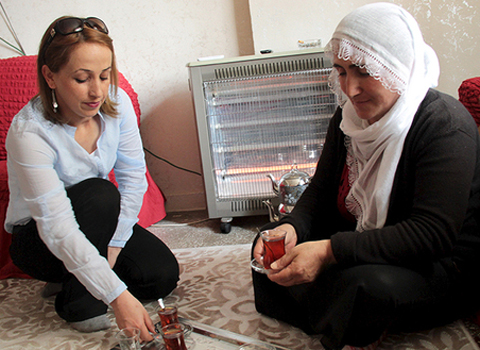How some Armenians are reclaiming their Christian faith in Turkey
How some Armenians are reclaiming their Christian faith in Turkey –
Nezahat Eleftos (R) chats with her daughter Leyla at her home in Diyarbakir, in the Kurdish-dominated southeastern Turkey, April 20, 2015. For nearly four decades, Eleftos tried to guard her grandmother Zarife’s secret that she too had been born a Christian Armenian, not a Muslim Kurd like all her neighbors. (photo by REUTERS/Sertac Kayar)
Al Monitor – The saga of Armenians who were compelled to live as Muslims goes back to 1915 massacres. Armenian children were adopted by Muslim families, women married Muslim men and some families converted to Islam to save their lives.
These Armenians, who for a century were forced to conceal their identities, are trying to return to their roots. This activity is more prevalent among Anatolian Armenians, particularly those from Dersim. It hasn’t caught on among Istanbul Armenians.
Miran Pirgic Gultekin is one of them. Gultekin explained to Al-Monitor how his family members saved themselves from the 1915 genocide by adopting Alevi identities. But not long after, they were caught up in the government’s 1937 Dersim massacres to put down the uprising of Dersim tribes. Some of his family members were killed; others were exiled. Those who returned after 10 years came back with Muslim names. Abraham had become Ibrahim. Since no records could be found, they were issued IDs with the new names they chose .
As they lived in predominantly Alevi Dersim, they, too, were recognized as Alevis. But the family tried to keep its Christian culture alive inside the house.
“When I was going to elementary school, I knew I was an Armenian but I didn’t know what it meant, that we have our distinct culture and religion,” Gultekin said. “At Easter time, my mother used to give us painted eggs but wouldn’t tell us this was a Christian ritual. All of us had Muslim names. My family used to listen to Radio Yerevan. But some in the village heard about all this and complained. I began to think of myself as Armenian when I was 18 years old. I had Armenian friends but nothing to read about my people. I didn’t know about 1915. The murder of journalist Hrant Dink affected me and when I was 48, I decided to return to my to my origins. I couldn’t do it before. There was pressure and fear. With my 70-year old father-in-law, my son and another relative we went to be baptized. Then I changed my name from Selahattin to Miran Pirgic.”
There have been many Anatolian Armenians who have resumed their authentic identities in group baptisms. The last such baptism occurred May 9 at Surp Istenapos Church of Yesilkoy-Istanbul. A dozen Armenians from Dersim were first given religious guidance and then baptized.
Miran Manukyan, a reporter for the Armenian newspaper Agos, covered the event and told Al-Monitor that this was a ceremony different than the usual rites. Generally, of course, children are baptized, but this time the baptisms were for adults who had not practiced their religion until adulthood.
‘‘I asked them one by one and they all gave the same answer: We are now free,” Manukyan said.
One of the participants was 30-year-old Yonca Gultekin of Dersim, who took the name of Lia. “Because my father was a civil servant, my parents concealed their Christian religion,” she told Al-Monitor. “When they declared they were from Dersim, they were automatically accepted to be Alevis. We went to church without letting neighbors and friends notice. My father was usually teaching in villages. We tried to hide my father’s Christianity, especially from his civil servant colleagues. We ended that secrecy once we came to Istanbul, where we went to church comfortably. After I finished university, I gathered my cousins to discuss the idea of baptism.”
They then went to the church and discussed it with a senior cleric. “We attended six-month religious course and then were baptized,” she said. “I will now change my identity and write Christian in the column for religion. My 63-year-old mother will also alter her identity and inscribe Christian on her ID card.”
Islamized Armenians was a taboo subject in Turkey until recently. People simply didn’t want to talk about it. But symposiums organized by the Hrant Dink Foundation (established in memory of the slain Armenian journalist) and other civil society organizations and frequent references to the matter by intellectuals were instrumental in easing the taboo.
The children of the Islamized Armenians also played a major role in overcoming the taboo.
Ayse Nevin Yildiz Tahincioglu, an instructor at Hacettepe University, spoke in a lecture about how a man branded his Armenian wife with a hot iron, marking her cross signs to ensure that she will remain a Muslim. Tahincioglu surprised the audience, saying: “These people who inflicted that brutality on a woman were [in] my family.”
Another notable is journalist Ahmet Abakay. In his book “Last Words of Hoshana,” he writes about his mother, who, until she was 82, had not revealed that she was an Armenian. His mother called him a day before her death and revealed that she was an Armenian. Abakay’s relatives were furious at him for giving away their secret after the book was published.
What’s apparent is that the Anatolian Armenians are getting organized, and many more are likely to emerge to recover their authentic identities.
Leading the effort is the Association of Dersim Armenians, which Gultekin set up.
Armenians of Malatya, Mus, Batman (Sason), Sivas and Hatay have also formed associations. Adiyaman and Diyarbakir will follow and help Anatolian Armenians known as Alevis, Kurds, Arabs and Muslim until now to assume their old identities. These associations are not only concerned with baptisms. Through their contacts with Armenia and Armenian NGOs in other provinces of Turkey, they are aiming to integrate Armenian youths and teach them their culture.

